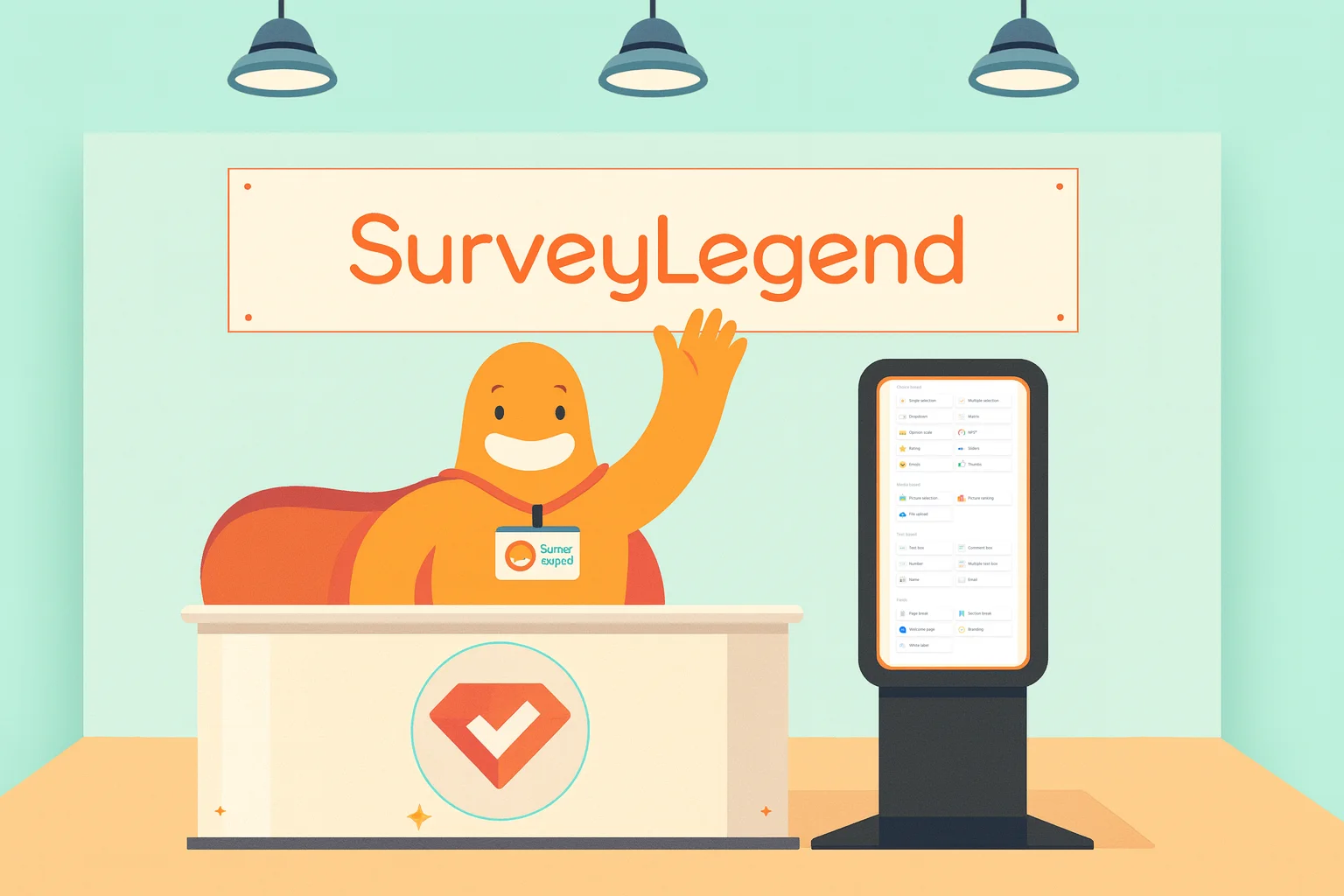Trade show exhibitor surveys are essential for gathering feedback, improving event quality, and increasing exhibitor satisfaction. This guide explains how to design effective pre- and post-event surveys, focusing on key areas such as venue, attendee engagement, ROI, and logistics. It outlines seven core survey sections with example questions, highlights mistakes to avoid—like leading or biased questions—and provides best practices for survey distribution. The article also explores how to use technology for real-time feedback, ensure survey validity, and analyze results to identify trends, prioritize improvements, and demonstrate event ROI. Thoughtful survey design helps organizers enhance future trade shows and strengthen exhibitor relationships.
Trade shows are big business! Except the pandemic years, in which social distancing was the norm, annual global exhibition spending is approximately $140 billion. Therefore, it’s important for companies and organizations putting on trade shows to keep their exhibitors happy. To achieve this, it’s crucial to include all the necessary questions in your exhibitor surveys to gather comprehensive feedback and insights from participants.
One way to do this is by creating exhibitor surveys, which allow you to collect feedback and gather valuable information to improve future trade shows.
Create Your FREE Trade Show Exhibitor Survey Now!
What is a Trade Show Exhibitor Survey?
A trade show exhibitor survey is a tool used by event organizers to gather feedback and insights from individuals or companies who have exhibited at their event. These surveys typically include questions aimed at assessing exhibitors’ overall satisfaction with the event, the effectiveness of the venue, the quality of attendee traffic, the usefulness of promotional activities, and any specific challenges or suggestions for improvement. While exhibitor surveys focus on the experience and needs of exhibitors, attendee survey questions are used to collect feedback from participants, helping organizers improve event quality, engagement, and the overall experience, especially in virtual and hybrid formats. Exhibitor surveys may also be conducted before the event to gauge exhibitor expectations and to determine their needs in advance. Analyzing survey data from exhibitor surveys enables event organizers to make informed decisions, enhance future events, and demonstrate ROI.
Setting Goals and Objectives
Before creating your post-event survey, event organizers need to set clear goals and objectives. Defining what you want to achieve with your event surveys will help you craft targeted survey questions that yield valuable data. Are you aiming to measure overall satisfaction, gather feedback on the event experience, or identify specific areas for improvement for future events? By pinpointing your survey’s purpose, you can ensure that every question serves a strategic function.
Start by identifying your target audience—are you surveying all exhibitors, or focusing on a particular segment? Next, determine the key metrics for success, such as satisfaction scores, actionable feedback, or suggestions for future events. For example, post-event survey questions like “What did you like most about the event?” or “What could we improve for future events?” can provide insights that help you make data-driven decisions. Setting these objectives upfront ensures your post-event surveys are focused, effective, and aligned with your event’s overall goals.
Create Your FREE Trade Show Exhibitor Survey Now!
What Do Exhibitors Look For In a Trade Show?
For exhibitors, the most important aspect of a trade show is the audience. To make the expense of exhibiting worthwhile, they need to attend shows with an audience demographic that fits whatever they’re selling. That’s why it’s so important that when marketing to exhibitors, you include details about your past trade show attendees and who you expect to be at your upcoming event. Expected attendance is also key; even if the demo fits, there needs to be enough of an audience to make it worth it. Targeting the right audience not only increases the relevance of your event but also maximizes exhibitor satisfaction and the likelihood of successful outcomes.
The second most important aspect for an exhibitor is their return on investment (ROI). Exhibiting at a trade show can require a sizable financial and time investment. When you add up the price of a trade show booth, booth space, signage, handouts, travel, accommodations, and other costs, it may cost an exhibitor tens of thousands of dollars, even for a small booth (referred to as an inline booth). Big brands with larger exhibits (often called peninsula or island exhibits) may spend ten times more. So, it’s important that you can show an exhibitor that the ROI potential justifies the expense. Exhibitors also evaluate event ROI by considering the number of leads generated and the effectiveness of their lead generation strategies, as these metrics directly impact their business outcomes and future participation decisions.
Create Your FREE Trade Show Exhibitor Survey Now!
Conducting Pre-Event and Post-Event Surveys
To truly understand the attendee experience and improve future events, it’s important to conduct both pre-event surveys and post-event surveys. Pre-event surveys allow event organizers to gauge expectations, fine-tune event logistics, and ensure that the event meets the needs of its audience. Questions like “What are your expectations for the event?” or “Which sessions are you most interested in?” help you plan more effectively and tailor your marketing strategies.
After the event, post-event surveys are invaluable for collecting feedback on what worked well and what could be improved. By asking survey questions such as “How would you rate your overall experience?” or “Did the event meet your expectations?”, you gather both quantitative and qualitative data that can inform your planning for future events. Effective surveys help event organizers identify trends, measure engagement, and evaluate the success of their efforts, ensuring each event is better than the last.
7 Areas To Focus On and Questions To Ask on Trade Show Exhibitor Surveys
When designing an exhibitor survey to distribute after a trade show, it’s essential to include questions that gather feedback on various aspects of the event. To maximize response rates, focus on designing questions that are likely to be answered by exhibitors, ensuring you collect meaningful data.
Here are some key areas and example trade show questions you might consider including on a trade show survey. Using a mix of quantitative and qualitative questions is important; including closed-ended questions, multiple-choice question formats, and open-ended feedback will help you gather comprehensive insights from your respondents.
1. Overall Satisfaction
These questions help measure overall event experience:
- How would you rate your overall satisfaction with the event?
- Do you think you will return for next year’s event?
- Would you recommend this event to others in your industry?
- On a scale of 0-10, how likely are you to recommend this event to a colleague? (This is your net promoter score question.)
2. Venue and Equipment
- How satisfied were you with the venue’s facilities and amenities?
- Were the exhibition space and layout conducive to showcasing your products/services effectively?
- Was the technology/equipment you needed readily available?
3. Attendee Traffic and Engagement
- Did the attendee traffic at the event meet your satisfaction? Participant feedback on attendee traffic and engagement is valuable for improving future events.
- Were the attendees in the demographic or industry you expected?
- How would you rate the quality of interactions with attendees?
4. Promotion and Marketing
- How effective were the event’s promotional activities in driving attendee engagement to your booth?
- Did you feel adequately informed about the event’s promotional efforts before the event?
- Did you interact with any of the event’s sponsors?
5. Logistics and Support
- How satisfied were you with the logistical support provided by the event organizers?
- Was the set-up and tear-down of your booth efficient?
- Were the pre-event communications clear and helpful?
6. Networking Opportunities
- Did you find ample networking opportunities at the event?
- Were the networking events or sessions valuable for establishing connections in your industry?
- Did you attend the networking cocktail party/dinner? (if applicable)
7. Suggestions for Improvement
- What aspects of the event could be improved to better meet your needs as an exhibitor and help shape better future experiences?
- Do you have any suggestions for enhancing future editions of the event to improve future trade shows?
- Is there anything else you would like to share about your experience as an exhibitor at this event?
Remember to consider including a mix of quantitative (rating scale) and qualitative (open-ended) questions to gather both numerical data and detailed feedback. Read more about the Differences Between Quantitative and Qualitative Surveys.
Create Your FREE Trade Show Exhibitor Survey Now!
Three Things to Avoid on an Exhibitor Trade Show Survey
When creating your exhibitor survey, there are some things to avoid to help ensure that your survey gathers meaningful and actionable feedback from exhibitors and that people complete them than dropping off out of frustration. Well-designed surveys, with a balanced mix of closed and open-ended questions, increase the likelihood of respondents completing the survey and providing comprehensive responses.
1. Asking Leading Loaded Questions
A leading question on a trade show exhibitor survey may ask, “How unique did you find our trade show?” As you can see, this question implies that the event was unique and may bias the respondent’s answer. A better-worded question would be, “Did you find our trade show unique?” A loaded question should also be avoided, because no matter how a respondent answers, they’re agreeing to something. For example, asking “Will you be back for another one of our innovative trade shows next year?” In this case, even if the respondent replies “no,” they’re still agreeing that the event is innovative, whether they think it was or not. Read more about leading and loaded questions.
2. Asking Biased Questions
Survey bias occurs when “systematic errors are introduced into sampling or testing by selecting or encouraging one outcome or answer over others.” For example, double-barreled questions that put two questions into one, such as “Did you like the venue and equipment?” This question could have two answers, as the respondent may have liked the venue but found the equipment lacking, or vice versa. So, it’s best to simply split it into two questions.
3. Making Surveys Too Long
Some exhibitors may have just spent a week at the trade show and may not be in the mood for a survey, so try to keep your surveys short if possible. You might even consider doing a number of microsurveys each day, sent via text once attendees have opted in. These would ask 5-7 quick exhibitor survey questions each day for higher levels of engagement. Plus, this way you’re collecting feedback “in the moment” when insights, suggestions, or criticisms are fresh on the exhibitor’s mind.
Create Your FREE Trade Show Exhibitor Survey Now!
Best Practices for Survey Distribution
How you distribute your surveys can make a big difference in response rates and the quality of feedback you receive. To maximize completion rates and collect valuable data, keep your post-event survey short and focused, using a mix of closed-ended and open-ended questions. Make your event survey questions easily accessible by sharing surveys via email, mobile devices, or even QR codes displayed at your event.
Consider offering incentives, such as discounts or exclusive resources, to encourage attendees to complete your surveys. Follow-up emails can also boost response rates and remind participants to share their insights. When planning your survey distribution, think about the best channels for your audience and the optimal timing—sending your post-event survey soon after the event ensures feedback is fresh and relevant. By following these best practices, event organizers can gather feedback and insights that drive meaningful improvements.
Create Your FREE Trade Show Exhibitor Survey Now!
Using Technology to Enhance Surveys
Leveraging technology can transform the way you create, distribute, and analyze your event surveys. Modern survey software allows event organizers to design engaging, mobile-friendly surveys that are easy for attendees to complete on any device. Features like logic and branching, real-time analytics, and multimedia integration can make your post-event survey questions more interactive and appealing, leading to higher response rates.
With online survey platforms and mobile apps, you can quickly distribute surveys, track responses, and gather feedback in real time. Data analytics tools help you identify trends, measure satisfaction, and gain insights that inform future events. By using technology to streamline the survey process, event organizers can collect more accurate data, create a better attendee experience, and make smarter decisions for their next event.
Create Your FREE Trade Show Exhibitor Survey Now!
Ensuring Survey Quality and Validity
To collect reliable and actionable feedback, it’s crucial to ensure the quality and validity of your surveys. Event organizers should pay attention to survey design, keeping surveys concise and using clear, unbiased language. Mixing question types—such as rating scales, multiple choice, and open-ended questions—can help you gather both quantitative and qualitative data.
Testing your post-event survey before full distribution, perhaps with a pilot group or focus group, can help identify confusing questions or technical issues. Monitoring response rates and adjusting your approach as needed will also improve the quality of your data. By focusing on survey quality and validity, event organizers can gather valuable data and insights that lead to more successful future events and higher exhibitor satisfaction.
Create Your FREE Trade Show Exhibitor Survey Now!
Analyzing Trade Show Exhibitor Surveys
Analyzing exhibitor survey results involves several steps to gain insights and identify areas for improvement. When reviewing survey data, consider analyzing responses related to booth performance, booth staff interactions, and the registration process to assess the event’s overall success. Here are some things to consider when doing an analysis of survey results.
Quantitative Analysis
This involves analyzing quantitative data by calculating averages, means, and percentages for questions with rating scales. When doing this, you’ll want to look for trends and patterns in the data. For example, are there particular aspects of the event that consistently received high or low ratings? This is something to focus on maintaining or improving for the next event. You may also want to segment the data based on relevant criteria such as exhibitor size, industry, or years of participation. This should be done to identify any differences in feedback among different groups.
Qualitative Analysis
This involves reviewing any open-ended responses to identify common themes, issues, or suggestions mentioned by exhibitors. You should categorize and code the qualitative data to organize it for analysis. This might involve grouping similar comments under specific topics or areas of concern.
Comparative Analysis
If you have conducted previous surveys following these events, compare those survey results with the results from this trade show. If possible, try to identify any improvements or declines in exhibitor satisfaction over time. Then, benchmark the survey results against industry standards or best practices to assess how the event’s performance compares to similar events.
Create Your FREE Trade Show Exhibitor Survey Now!
Root Cause Analysis
If you want to really get at the heart of things, dig deeper into areas with particularly low ratings or recurring issues to understand the underlying causes. This may involve conducting follow-up interviews with exhibitors or internal discussions with event staff.
Prioritize Action Items
Based on your survey analysis, prioritize action items for improvement. Focus on addressing high-impact issues that are likely to have the greatest positive effect on exhibitor satisfaction and event success. Consider the feasibility and resources required for implementing proposed changes when prioritizing action items.
Communicate Findings and Plan Next Steps
Prepare a summary report for sharing that includes the survey findings, with key insights, recommendations, and proposed action items. Share the report with relevant stakeholders, including event organizers, venue staff, and other key decision-makers. Finally, develop an action plan outlining specific steps to address the identified issues and improve the exhibitor experience for future events.
By following these steps, event organizers can effectively analyze exhibitor survey results and use the findings to make informed decisions aimed at enhancing the overall quality and success of their events. SurveyLegend provides a wealth of analytics in real-time and at the conclusion of every survey, which makes this step much easier!
Create Your FREE Trade Show Exhibitor Survey Now!
Conclusion
Holding a successful trade show means bringing together the right mix of exhibitors and attendees (be sure to check out our blog focusing on attendees, How To Create A Conference or Summit Survey). For event planners and companies putting on a trade show, it’s important to survey exhibitors to understand how successful they found the event to be, because what you don’t know can hurt you; if they were unsatisfied but you’re unaware, you won’t be able to make improvements, and they won’t be back for the next one.
Ready to create your exhibitor survey? Check out our event survey templates here or create your own! Event planners love our easy-to-use survey tool, which makes designing beautiful and insightful surveys a cinch. You can choose from many different question types and themes. And, at the conclusion of the survey, you’ll receive powerful analytics. Start today for free!
Do you host trade shows? Or are you a regular exhibitor? Let us know what you think is most important for creating a successful event!
Create Your FREE Trade Show Exhibitor Survey Now!
Frequently Asked Questions
How many trade shows are there annually?
According to trade show statistics, there are approximately 20,000 international trade show events each year. The United States hosts the most, at about 10,000, which accounts for nearly half the world’s trade show events each year.
What are the top destinations for trade shows?
Choosing a trade show destination involves looking at which cities have the best infrastructure and attractions.
- Paris, France
- Frankfurt, Germany
- Shanghai, China
- Dubai, UAE
- Las Vegas, USA
Why should you conduct trade show surveys?
Trade show surveys should be conducted to get exhibitor and attendee opinions of the event. Both groups need to be satisfied to keep attendance high for future events. Only by surveying will event planners know if the trade show met expectations.



